Comprehensive Report: Lesson Planning, Assessment, and Evaluation
VerifiedAdded on 2023/06/14
|18
|5198
|207
Report
AI Summary
This report provides a detailed analysis of lesson planning, emphasizing the importance of incorporating learning styles, assessment, and evaluation methods. It explores the aims and characteristics of effective lesson plans, including how to design them to meet the needs and goals of learners. The report examines learning taxonomies like Bloom's and Maslow's hierarchy, and learning styles such as VARK and SOLO, explaining how these can be integrated into lesson plans to ensure inclusivity. Adaptability and flexibility in lesson plan design are discussed, along with the impact of lesson planning on inclusive teaching. The report also defines assessment and evaluation, analyzing different methods and the use of differentiated assessments to cater to individual learner needs. Finally, it explains how the analysis of assessment and evaluation results can inform future lesson planning, enhancing the overall teaching and learning experience. This resource, contributed by a student, is available on Desklib, offering valuable insights and study tools for educators.
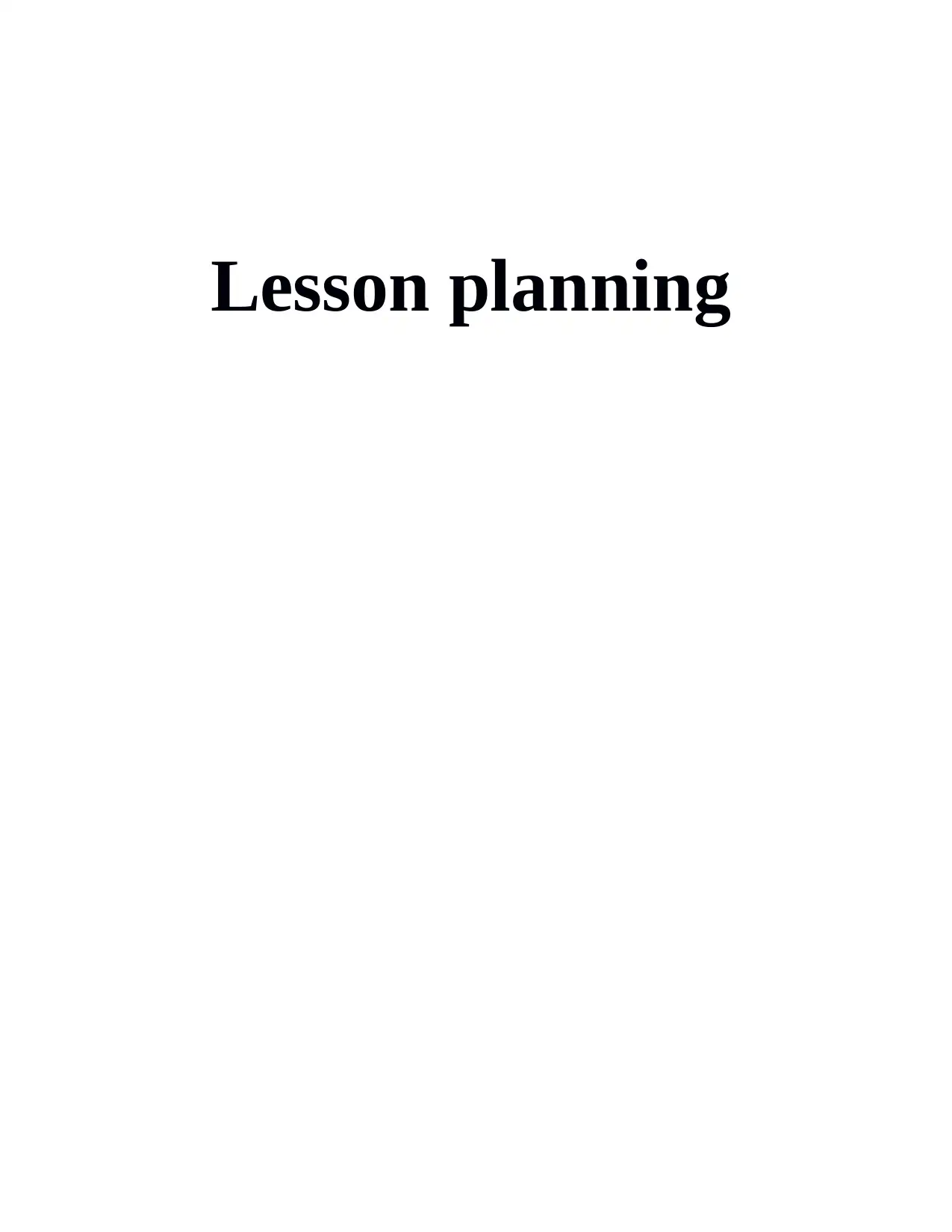
Lesson planning
Paraphrase This Document
Need a fresh take? Get an instant paraphrase of this document with our AI Paraphraser
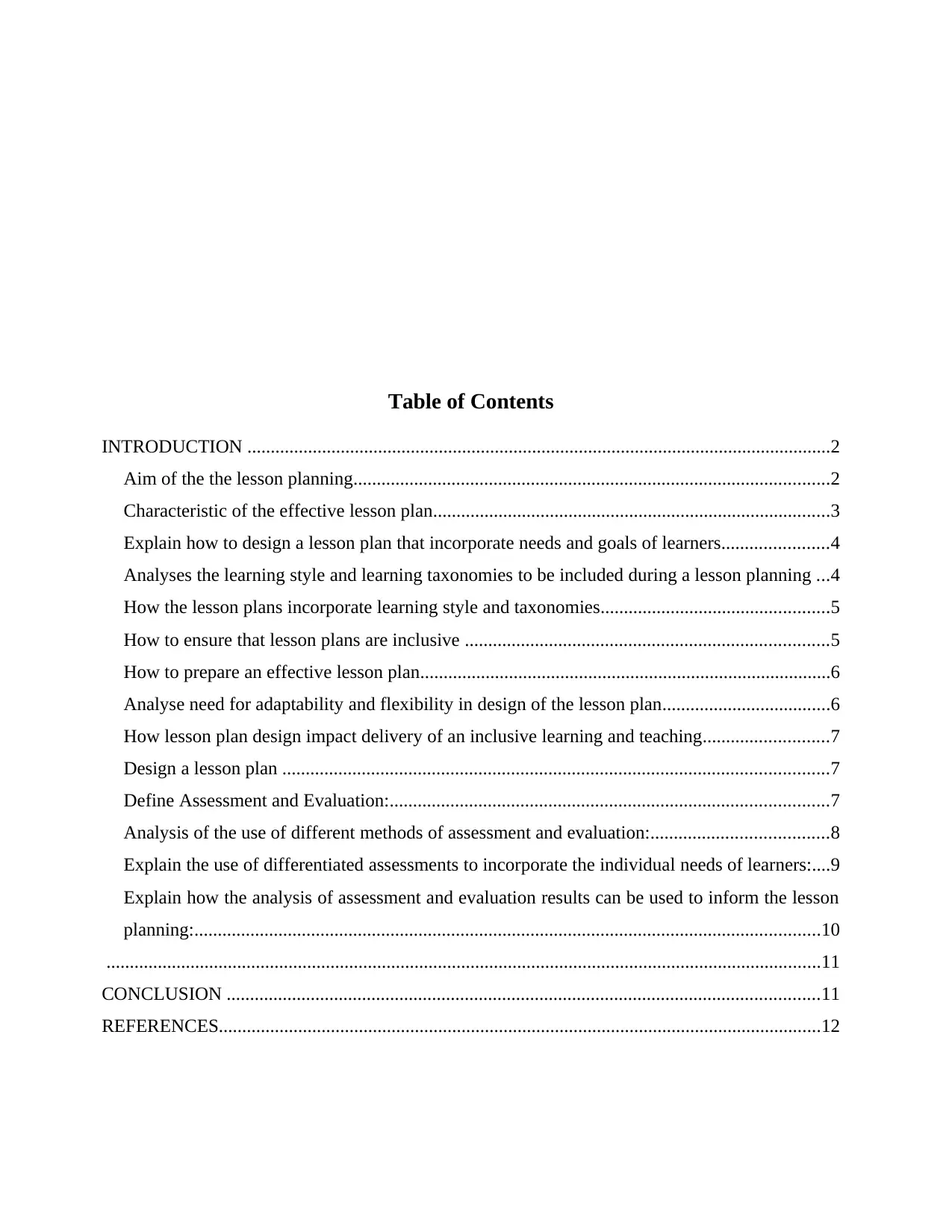
Table of Contents
INTRODUCTION .............................................................................................................................2
Aim of the the lesson planning......................................................................................................2
Characteristic of the effective lesson plan.....................................................................................3
Explain how to design a lesson plan that incorporate needs and goals of learners.......................4
Analyses the learning style and learning taxonomies to be included during a lesson planning ...4
How the lesson plans incorporate learning style and taxonomies.................................................5
How to ensure that lesson plans are inclusive ..............................................................................5
How to prepare an effective lesson plan........................................................................................6
Analyse need for adaptability and flexibility in design of the lesson plan....................................6
How lesson plan design impact delivery of an inclusive learning and teaching...........................7
Design a lesson plan .....................................................................................................................7
Define Assessment and Evaluation:..............................................................................................7
Analysis of the use of different methods of assessment and evaluation:......................................8
Explain the use of differentiated assessments to incorporate the individual needs of learners:....9
Explain how the analysis of assessment and evaluation results can be used to inform the lesson
planning:......................................................................................................................................10
.........................................................................................................................................................11
CONCLUSION ...............................................................................................................................11
REFERENCES.................................................................................................................................12
INTRODUCTION .............................................................................................................................2
Aim of the the lesson planning......................................................................................................2
Characteristic of the effective lesson plan.....................................................................................3
Explain how to design a lesson plan that incorporate needs and goals of learners.......................4
Analyses the learning style and learning taxonomies to be included during a lesson planning ...4
How the lesson plans incorporate learning style and taxonomies.................................................5
How to ensure that lesson plans are inclusive ..............................................................................5
How to prepare an effective lesson plan........................................................................................6
Analyse need for adaptability and flexibility in design of the lesson plan....................................6
How lesson plan design impact delivery of an inclusive learning and teaching...........................7
Design a lesson plan .....................................................................................................................7
Define Assessment and Evaluation:..............................................................................................7
Analysis of the use of different methods of assessment and evaluation:......................................8
Explain the use of differentiated assessments to incorporate the individual needs of learners:....9
Explain how the analysis of assessment and evaluation results can be used to inform the lesson
planning:......................................................................................................................................10
.........................................................................................................................................................11
CONCLUSION ...............................................................................................................................11
REFERENCES.................................................................................................................................12
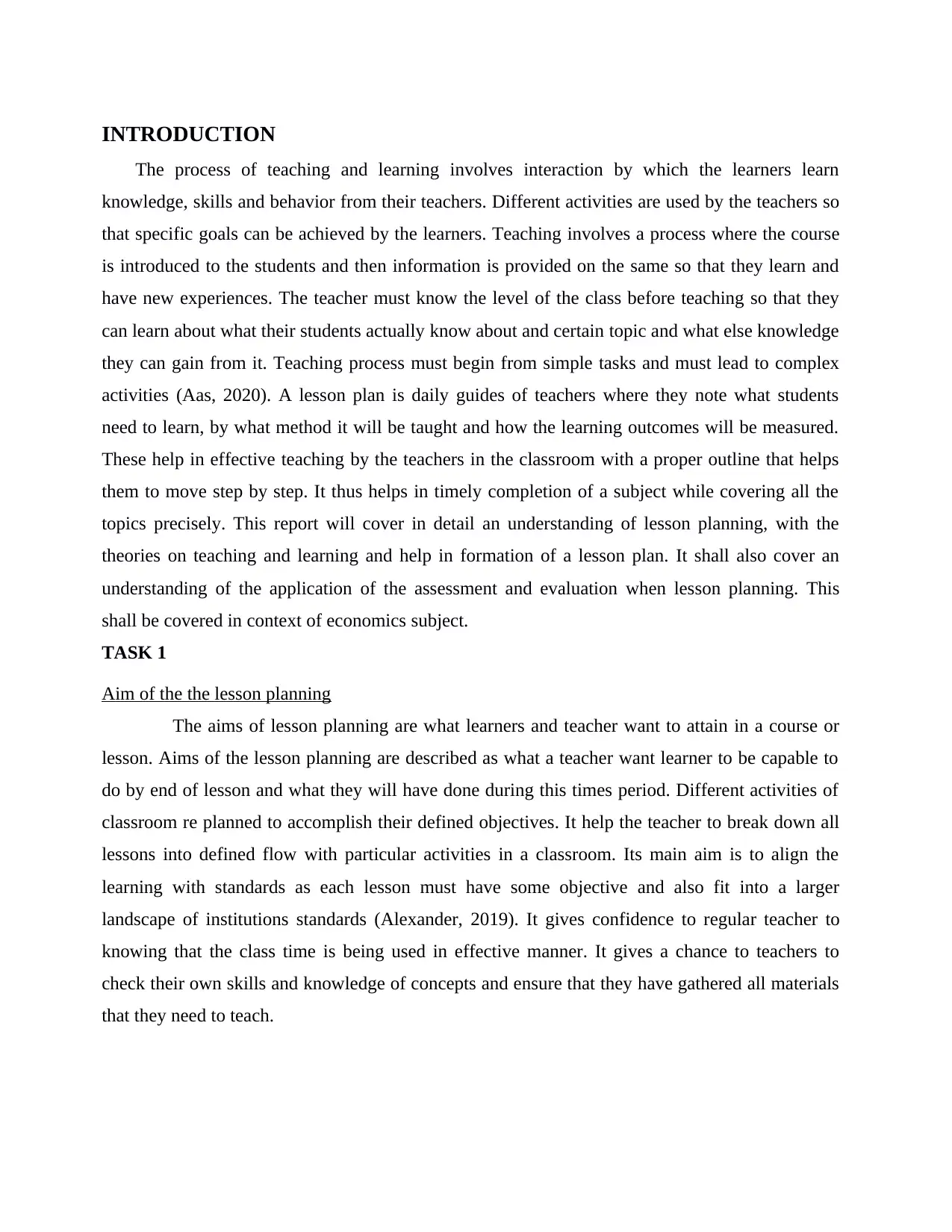
INTRODUCTION
The process of teaching and learning involves interaction by which the learners learn
knowledge, skills and behavior from their teachers. Different activities are used by the teachers so
that specific goals can be achieved by the learners. Teaching involves a process where the course
is introduced to the students and then information is provided on the same so that they learn and
have new experiences. The teacher must know the level of the class before teaching so that they
can learn about what their students actually know about and certain topic and what else knowledge
they can gain from it. Teaching process must begin from simple tasks and must lead to complex
activities (Aas, 2020). A lesson plan is daily guides of teachers where they note what students
need to learn, by what method it will be taught and how the learning outcomes will be measured.
These help in effective teaching by the teachers in the classroom with a proper outline that helps
them to move step by step. It thus helps in timely completion of a subject while covering all the
topics precisely. This report will cover in detail an understanding of lesson planning, with the
theories on teaching and learning and help in formation of a lesson plan. It shall also cover an
understanding of the application of the assessment and evaluation when lesson planning. This
shall be covered in context of economics subject.
TASK 1
Aim of the the lesson planning
The aims of lesson planning are what learners and teacher want to attain in a course or
lesson. Aims of the lesson planning are described as what a teacher want learner to be capable to
do by end of lesson and what they will have done during this times period. Different activities of
classroom re planned to accomplish their defined objectives. It help the teacher to break down all
lessons into defined flow with particular activities in a classroom. Its main aim is to align the
learning with standards as each lesson must have some objective and also fit into a larger
landscape of institutions standards (Alexander, 2019). It gives confidence to regular teacher to
knowing that the class time is being used in effective manner. It gives a chance to teachers to
check their own skills and knowledge of concepts and ensure that they have gathered all materials
that they need to teach.
The process of teaching and learning involves interaction by which the learners learn
knowledge, skills and behavior from their teachers. Different activities are used by the teachers so
that specific goals can be achieved by the learners. Teaching involves a process where the course
is introduced to the students and then information is provided on the same so that they learn and
have new experiences. The teacher must know the level of the class before teaching so that they
can learn about what their students actually know about and certain topic and what else knowledge
they can gain from it. Teaching process must begin from simple tasks and must lead to complex
activities (Aas, 2020). A lesson plan is daily guides of teachers where they note what students
need to learn, by what method it will be taught and how the learning outcomes will be measured.
These help in effective teaching by the teachers in the classroom with a proper outline that helps
them to move step by step. It thus helps in timely completion of a subject while covering all the
topics precisely. This report will cover in detail an understanding of lesson planning, with the
theories on teaching and learning and help in formation of a lesson plan. It shall also cover an
understanding of the application of the assessment and evaluation when lesson planning. This
shall be covered in context of economics subject.
TASK 1
Aim of the the lesson planning
The aims of lesson planning are what learners and teacher want to attain in a course or
lesson. Aims of the lesson planning are described as what a teacher want learner to be capable to
do by end of lesson and what they will have done during this times period. Different activities of
classroom re planned to accomplish their defined objectives. It help the teacher to break down all
lessons into defined flow with particular activities in a classroom. Its main aim is to align the
learning with standards as each lesson must have some objective and also fit into a larger
landscape of institutions standards (Alexander, 2019). It gives confidence to regular teacher to
knowing that the class time is being used in effective manner. It gives a chance to teachers to
check their own skills and knowledge of concepts and ensure that they have gathered all materials
that they need to teach.
⊘ This is a preview!⊘
Do you want full access?
Subscribe today to unlock all pages.

Trusted by 1+ million students worldwide

Characteristic of the effective lesson plan
In institutions, a lesson plan should be effective so that it can understandable by the
students. Effective lesson plan must state objectives or aims, students’ engagement, break down
the topic and also allow the students to demonstrate better understanding.
An effective lesson plan should not remain at mental or oral stage; it should be in written
format as it will be helpful in clarifying the concentration and thoughts.
It is essential that the lesson plan should have a base on class's background and should not
let lesson remain isolate one.
An effective lesson plan contains a suitable subject matter carefully organized and gives
enough scope to students to be active.
It is not right to follow a lesson plan lavishly. It should be flexible which can be modified
with new changes.
An effective lesson plan include summary of whole lesson that can be developed on
blackboard.
A good lesson plan contain suitable plan in context of self criticism. (Anderson, 2021).
In institutions, a lesson plan should be effective so that it can understandable by the
students. Effective lesson plan must state objectives or aims, students’ engagement, break down
the topic and also allow the students to demonstrate better understanding.
An effective lesson plan should not remain at mental or oral stage; it should be in written
format as it will be helpful in clarifying the concentration and thoughts.
It is essential that the lesson plan should have a base on class's background and should not
let lesson remain isolate one.
An effective lesson plan contains a suitable subject matter carefully organized and gives
enough scope to students to be active.
It is not right to follow a lesson plan lavishly. It should be flexible which can be modified
with new changes.
An effective lesson plan include summary of whole lesson that can be developed on
blackboard.
A good lesson plan contain suitable plan in context of self criticism. (Anderson, 2021).
Paraphrase This Document
Need a fresh take? Get an instant paraphrase of this document with our AI Paraphraser
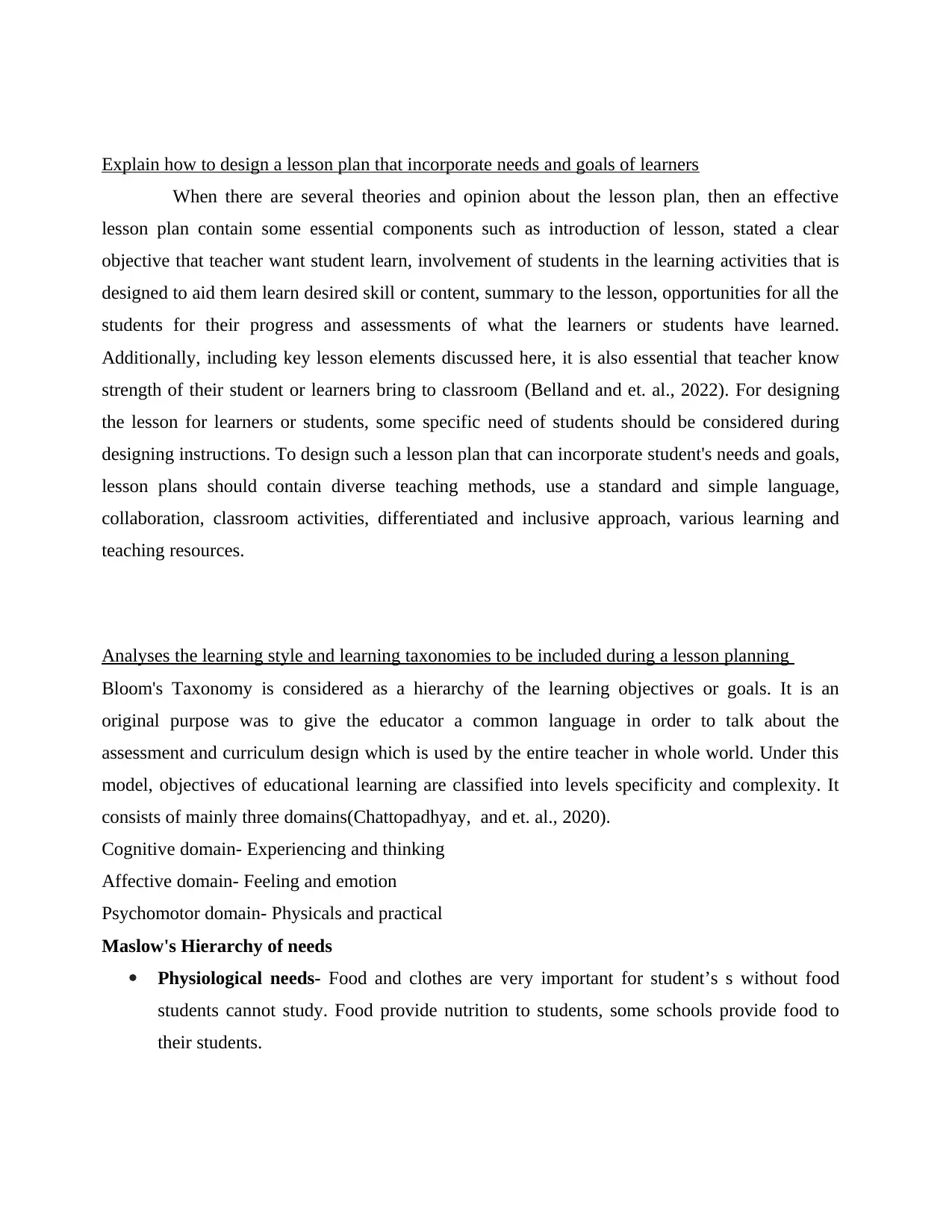
Explain how to design a lesson plan that incorporate needs and goals of learners
When there are several theories and opinion about the lesson plan, then an effective
lesson plan contain some essential components such as introduction of lesson, stated a clear
objective that teacher want student learn, involvement of students in the learning activities that is
designed to aid them learn desired skill or content, summary to the lesson, opportunities for all the
students for their progress and assessments of what the learners or students have learned.
Additionally, including key lesson elements discussed here, it is also essential that teacher know
strength of their student or learners bring to classroom (Belland and et. al., 2022). For designing
the lesson for learners or students, some specific need of students should be considered during
designing instructions. To design such a lesson plan that can incorporate student's needs and goals,
lesson plans should contain diverse teaching methods, use a standard and simple language,
collaboration, classroom activities, differentiated and inclusive approach, various learning and
teaching resources.
Analyses the learning style and learning taxonomies to be included during a lesson planning
Bloom's Taxonomy is considered as a hierarchy of the learning objectives or goals. It is an
original purpose was to give the educator a common language in order to talk about the
assessment and curriculum design which is used by the entire teacher in whole world. Under this
model, objectives of educational learning are classified into levels specificity and complexity. It
consists of mainly three domains(Chattopadhyay, and et. al., 2020).
Cognitive domain- Experiencing and thinking
Affective domain- Feeling and emotion
Psychomotor domain- Physicals and practical
Maslow's Hierarchy of needs
Physiological needs- Food and clothes are very important for student’s s without food
students cannot study. Food provide nutrition to students, some schools provide food to
their students.
When there are several theories and opinion about the lesson plan, then an effective
lesson plan contain some essential components such as introduction of lesson, stated a clear
objective that teacher want student learn, involvement of students in the learning activities that is
designed to aid them learn desired skill or content, summary to the lesson, opportunities for all the
students for their progress and assessments of what the learners or students have learned.
Additionally, including key lesson elements discussed here, it is also essential that teacher know
strength of their student or learners bring to classroom (Belland and et. al., 2022). For designing
the lesson for learners or students, some specific need of students should be considered during
designing instructions. To design such a lesson plan that can incorporate student's needs and goals,
lesson plans should contain diverse teaching methods, use a standard and simple language,
collaboration, classroom activities, differentiated and inclusive approach, various learning and
teaching resources.
Analyses the learning style and learning taxonomies to be included during a lesson planning
Bloom's Taxonomy is considered as a hierarchy of the learning objectives or goals. It is an
original purpose was to give the educator a common language in order to talk about the
assessment and curriculum design which is used by the entire teacher in whole world. Under this
model, objectives of educational learning are classified into levels specificity and complexity. It
consists of mainly three domains(Chattopadhyay, and et. al., 2020).
Cognitive domain- Experiencing and thinking
Affective domain- Feeling and emotion
Psychomotor domain- Physicals and practical
Maslow's Hierarchy of needs
Physiological needs- Food and clothes are very important for student’s s without food
students cannot study. Food provide nutrition to students, some schools provide food to
their students.
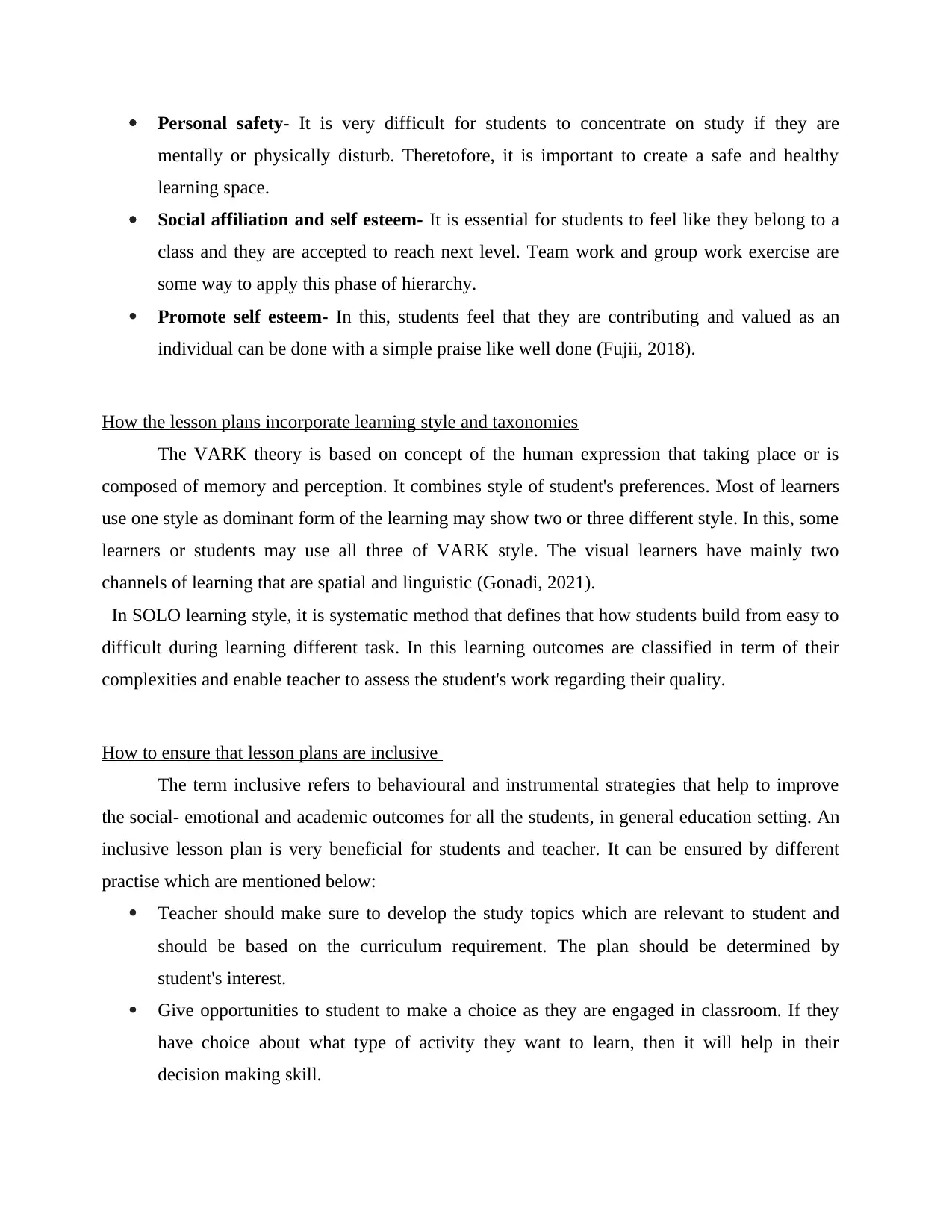
Personal safety- It is very difficult for students to concentrate on study if they are
mentally or physically disturb. Theretofore, it is important to create a safe and healthy
learning space.
Social affiliation and self esteem- It is essential for students to feel like they belong to a
class and they are accepted to reach next level. Team work and group work exercise are
some way to apply this phase of hierarchy.
Promote self esteem- In this, students feel that they are contributing and valued as an
individual can be done with a simple praise like well done (Fujii, 2018).
How the lesson plans incorporate learning style and taxonomies
The VARK theory is based on concept of the human expression that taking place or is
composed of memory and perception. It combines style of student's preferences. Most of learners
use one style as dominant form of the learning may show two or three different style. In this, some
learners or students may use all three of VARK style. The visual learners have mainly two
channels of learning that are spatial and linguistic (Gonadi, 2021).
In SOLO learning style, it is systematic method that defines that how students build from easy to
difficult during learning different task. In this learning outcomes are classified in term of their
complexities and enable teacher to assess the student's work regarding their quality.
How to ensure that lesson plans are inclusive
The term inclusive refers to behavioural and instrumental strategies that help to improve
the social- emotional and academic outcomes for all the students, in general education setting. An
inclusive lesson plan is very beneficial for students and teacher. It can be ensured by different
practise which are mentioned below:
Teacher should make sure to develop the study topics which are relevant to student and
should be based on the curriculum requirement. The plan should be determined by
student's interest.
Give opportunities to student to make a choice as they are engaged in classroom. If they
have choice about what type of activity they want to learn, then it will help in their
decision making skill.
mentally or physically disturb. Theretofore, it is important to create a safe and healthy
learning space.
Social affiliation and self esteem- It is essential for students to feel like they belong to a
class and they are accepted to reach next level. Team work and group work exercise are
some way to apply this phase of hierarchy.
Promote self esteem- In this, students feel that they are contributing and valued as an
individual can be done with a simple praise like well done (Fujii, 2018).
How the lesson plans incorporate learning style and taxonomies
The VARK theory is based on concept of the human expression that taking place or is
composed of memory and perception. It combines style of student's preferences. Most of learners
use one style as dominant form of the learning may show two or three different style. In this, some
learners or students may use all three of VARK style. The visual learners have mainly two
channels of learning that are spatial and linguistic (Gonadi, 2021).
In SOLO learning style, it is systematic method that defines that how students build from easy to
difficult during learning different task. In this learning outcomes are classified in term of their
complexities and enable teacher to assess the student's work regarding their quality.
How to ensure that lesson plans are inclusive
The term inclusive refers to behavioural and instrumental strategies that help to improve
the social- emotional and academic outcomes for all the students, in general education setting. An
inclusive lesson plan is very beneficial for students and teacher. It can be ensured by different
practise which are mentioned below:
Teacher should make sure to develop the study topics which are relevant to student and
should be based on the curriculum requirement. The plan should be determined by
student's interest.
Give opportunities to student to make a choice as they are engaged in classroom. If they
have choice about what type of activity they want to learn, then it will help in their
decision making skill.
⊘ This is a preview!⊘
Do you want full access?
Subscribe today to unlock all pages.

Trusted by 1+ million students worldwide
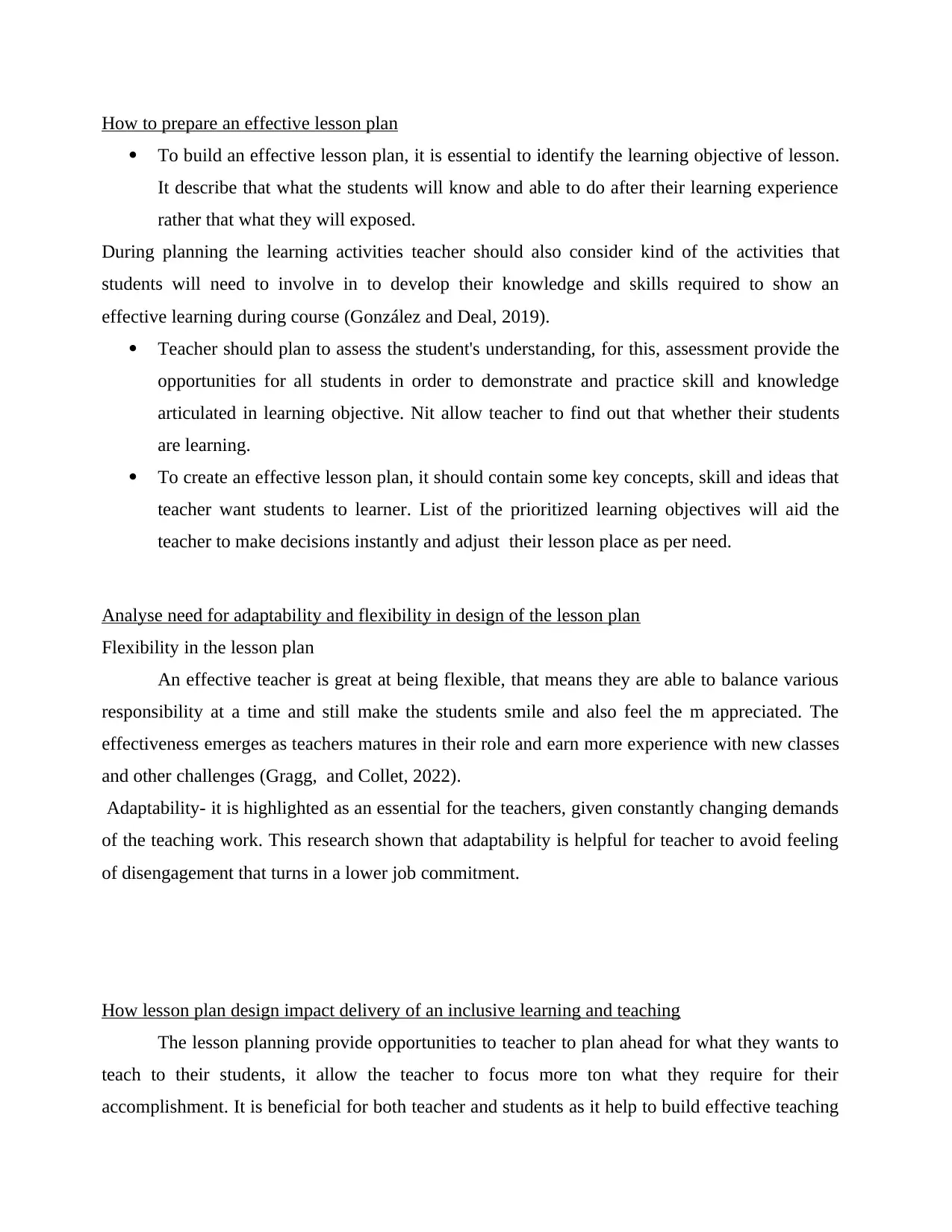
How to prepare an effective lesson plan
To build an effective lesson plan, it is essential to identify the learning objective of lesson.
It describe that what the students will know and able to do after their learning experience
rather that what they will exposed.
During planning the learning activities teacher should also consider kind of the activities that
students will need to involve in to develop their knowledge and skills required to show an
effective learning during course (González and Deal, 2019).
Teacher should plan to assess the student's understanding, for this, assessment provide the
opportunities for all students in order to demonstrate and practice skill and knowledge
articulated in learning objective. Nit allow teacher to find out that whether their students
are learning.
To create an effective lesson plan, it should contain some key concepts, skill and ideas that
teacher want students to learner. List of the prioritized learning objectives will aid the
teacher to make decisions instantly and adjust their lesson place as per need.
Analyse need for adaptability and flexibility in design of the lesson plan
Flexibility in the lesson plan
An effective teacher is great at being flexible, that means they are able to balance various
responsibility at a time and still make the students smile and also feel the m appreciated. The
effectiveness emerges as teachers matures in their role and earn more experience with new classes
and other challenges (Gragg, and Collet, 2022).
Adaptability- it is highlighted as an essential for the teachers, given constantly changing demands
of the teaching work. This research shown that adaptability is helpful for teacher to avoid feeling
of disengagement that turns in a lower job commitment.
How lesson plan design impact delivery of an inclusive learning and teaching
The lesson planning provide opportunities to teacher to plan ahead for what they wants to
teach to their students, it allow the teacher to focus more ton what they require for their
accomplishment. It is beneficial for both teacher and students as it help to build effective teaching
To build an effective lesson plan, it is essential to identify the learning objective of lesson.
It describe that what the students will know and able to do after their learning experience
rather that what they will exposed.
During planning the learning activities teacher should also consider kind of the activities that
students will need to involve in to develop their knowledge and skills required to show an
effective learning during course (González and Deal, 2019).
Teacher should plan to assess the student's understanding, for this, assessment provide the
opportunities for all students in order to demonstrate and practice skill and knowledge
articulated in learning objective. Nit allow teacher to find out that whether their students
are learning.
To create an effective lesson plan, it should contain some key concepts, skill and ideas that
teacher want students to learner. List of the prioritized learning objectives will aid the
teacher to make decisions instantly and adjust their lesson place as per need.
Analyse need for adaptability and flexibility in design of the lesson plan
Flexibility in the lesson plan
An effective teacher is great at being flexible, that means they are able to balance various
responsibility at a time and still make the students smile and also feel the m appreciated. The
effectiveness emerges as teachers matures in their role and earn more experience with new classes
and other challenges (Gragg, and Collet, 2022).
Adaptability- it is highlighted as an essential for the teachers, given constantly changing demands
of the teaching work. This research shown that adaptability is helpful for teacher to avoid feeling
of disengagement that turns in a lower job commitment.
How lesson plan design impact delivery of an inclusive learning and teaching
The lesson planning provide opportunities to teacher to plan ahead for what they wants to
teach to their students, it allow the teacher to focus more ton what they require for their
accomplishment. It is beneficial for both teacher and students as it help to build effective teaching
Paraphrase This Document
Need a fresh take? Get an instant paraphrase of this document with our AI Paraphraser
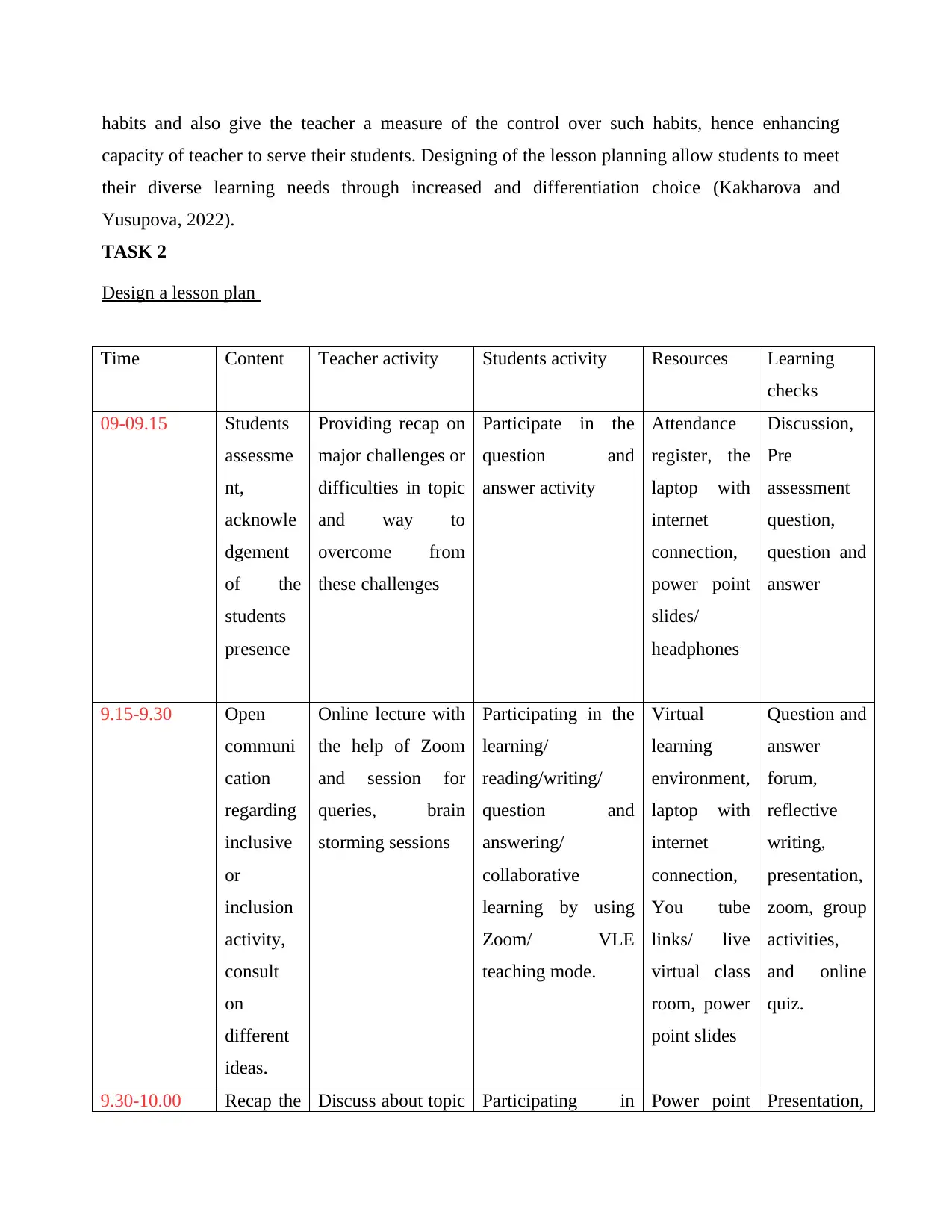
habits and also give the teacher a measure of the control over such habits, hence enhancing
capacity of teacher to serve their students. Designing of the lesson planning allow students to meet
their diverse learning needs through increased and differentiation choice (Kakharova and
Yusupova, 2022).
TASK 2
Design a lesson plan
Time Content Teacher activity Students activity Resources Learning
checks
09-09.15 Students
assessme
nt,
acknowle
dgement
of the
students
presence
Providing recap on
major challenges or
difficulties in topic
and way to
overcome from
these challenges
Participate in the
question and
answer activity
Attendance
register, the
laptop with
internet
connection,
power point
slides/
headphones
Discussion,
Pre
assessment
question,
question and
answer
9.15-9.30 Open
communi
cation
regarding
inclusive
or
inclusion
activity,
consult
on
different
ideas.
Online lecture with
the help of Zoom
and session for
queries, brain
storming sessions
Participating in the
learning/
reading/writing/
question and
answering/
collaborative
learning by using
Zoom/ VLE
teaching mode.
Virtual
learning
environment,
laptop with
internet
connection,
You tube
links/ live
virtual class
room, power
point slides
Question and
answer
forum,
reflective
writing,
presentation,
zoom, group
activities,
and online
quiz.
9.30-10.00 Recap the Discuss about topic Participating in Power point Presentation,
capacity of teacher to serve their students. Designing of the lesson planning allow students to meet
their diverse learning needs through increased and differentiation choice (Kakharova and
Yusupova, 2022).
TASK 2
Design a lesson plan
Time Content Teacher activity Students activity Resources Learning
checks
09-09.15 Students
assessme
nt,
acknowle
dgement
of the
students
presence
Providing recap on
major challenges or
difficulties in topic
and way to
overcome from
these challenges
Participate in the
question and
answer activity
Attendance
register, the
laptop with
internet
connection,
power point
slides/
headphones
Discussion,
Pre
assessment
question,
question and
answer
9.15-9.30 Open
communi
cation
regarding
inclusive
or
inclusion
activity,
consult
on
different
ideas.
Online lecture with
the help of Zoom
and session for
queries, brain
storming sessions
Participating in the
learning/
reading/writing/
question and
answering/
collaborative
learning by using
Zoom/ VLE
teaching mode.
Virtual
learning
environment,
laptop with
internet
connection,
You tube
links/ live
virtual class
room, power
point slides
Question and
answer
forum,
reflective
writing,
presentation,
zoom, group
activities,
and online
quiz.
9.30-10.00 Recap the Discuss about topic Participating in Power point Presentation,
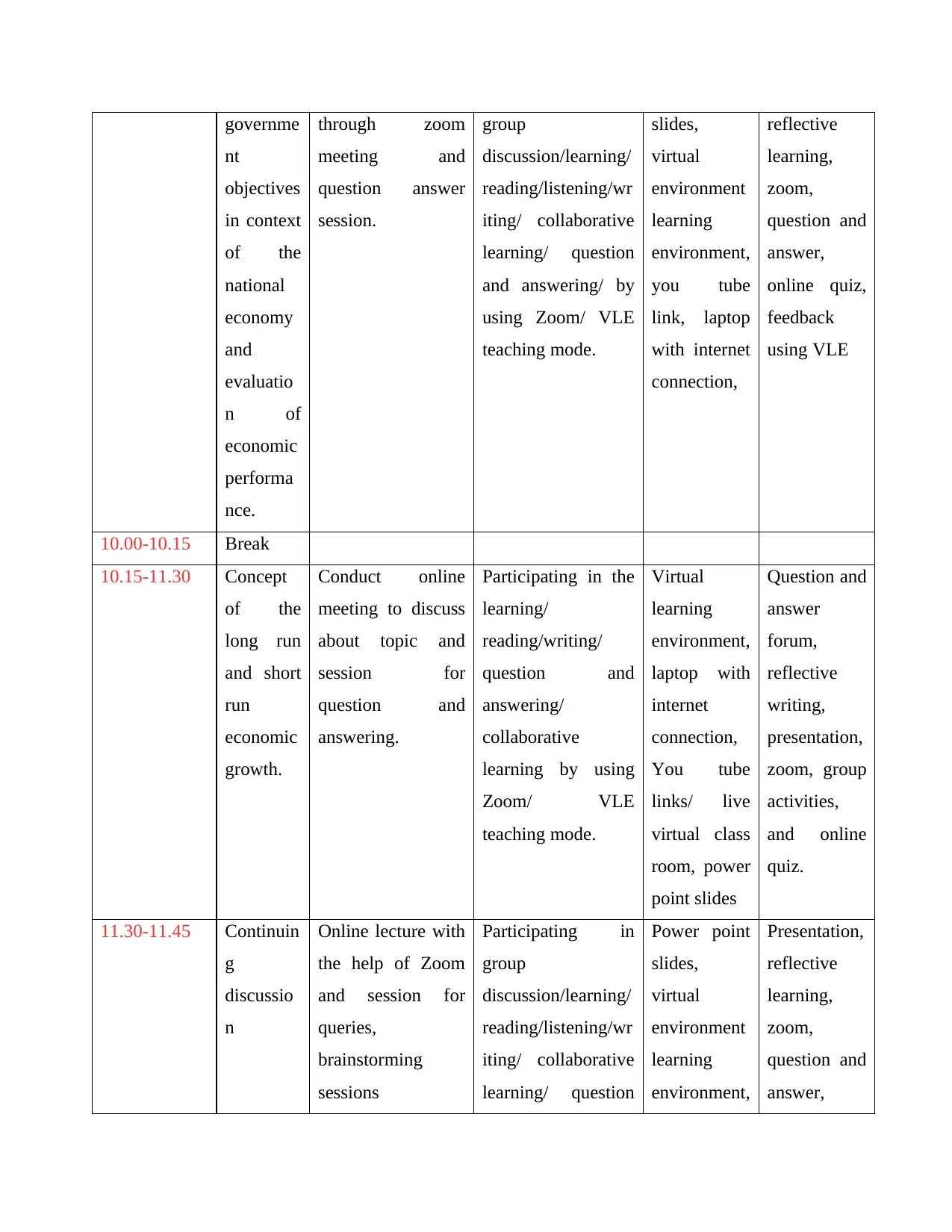
governme
nt
objectives
in context
of the
national
economy
and
evaluatio
n of
economic
performa
nce.
through zoom
meeting and
question answer
session.
group
discussion/learning/
reading/listening/wr
iting/ collaborative
learning/ question
and answering/ by
using Zoom/ VLE
teaching mode.
slides,
virtual
environment
learning
environment,
you tube
link, laptop
with internet
connection,
reflective
learning,
zoom,
question and
answer,
online quiz,
feedback
using VLE
10.00-10.15 Break
10.15-11.30 Concept
of the
long run
and short
run
economic
growth.
Conduct online
meeting to discuss
about topic and
session for
question and
answering.
Participating in the
learning/
reading/writing/
question and
answering/
collaborative
learning by using
Zoom/ VLE
teaching mode.
Virtual
learning
environment,
laptop with
internet
connection,
You tube
links/ live
virtual class
room, power
point slides
Question and
answer
forum,
reflective
writing,
presentation,
zoom, group
activities,
and online
quiz.
11.30-11.45 Continuin
g
discussio
n
Online lecture with
the help of Zoom
and session for
queries,
brainstorming
sessions
Participating in
group
discussion/learning/
reading/listening/wr
iting/ collaborative
learning/ question
Power point
slides,
virtual
environment
learning
environment,
Presentation,
reflective
learning,
zoom,
question and
answer,
nt
objectives
in context
of the
national
economy
and
evaluatio
n of
economic
performa
nce.
through zoom
meeting and
question answer
session.
group
discussion/learning/
reading/listening/wr
iting/ collaborative
learning/ question
and answering/ by
using Zoom/ VLE
teaching mode.
slides,
virtual
environment
learning
environment,
you tube
link, laptop
with internet
connection,
reflective
learning,
zoom,
question and
answer,
online quiz,
feedback
using VLE
10.00-10.15 Break
10.15-11.30 Concept
of the
long run
and short
run
economic
growth.
Conduct online
meeting to discuss
about topic and
session for
question and
answering.
Participating in the
learning/
reading/writing/
question and
answering/
collaborative
learning by using
Zoom/ VLE
teaching mode.
Virtual
learning
environment,
laptop with
internet
connection,
You tube
links/ live
virtual class
room, power
point slides
Question and
answer
forum,
reflective
writing,
presentation,
zoom, group
activities,
and online
quiz.
11.30-11.45 Continuin
g
discussio
n
Online lecture with
the help of Zoom
and session for
queries,
brainstorming
sessions
Participating in
group
discussion/learning/
reading/listening/wr
iting/ collaborative
learning/ question
Power point
slides,
virtual
environment
learning
environment,
Presentation,
reflective
learning,
zoom,
question and
answer,
⊘ This is a preview!⊘
Do you want full access?
Subscribe today to unlock all pages.

Trusted by 1+ million students worldwide
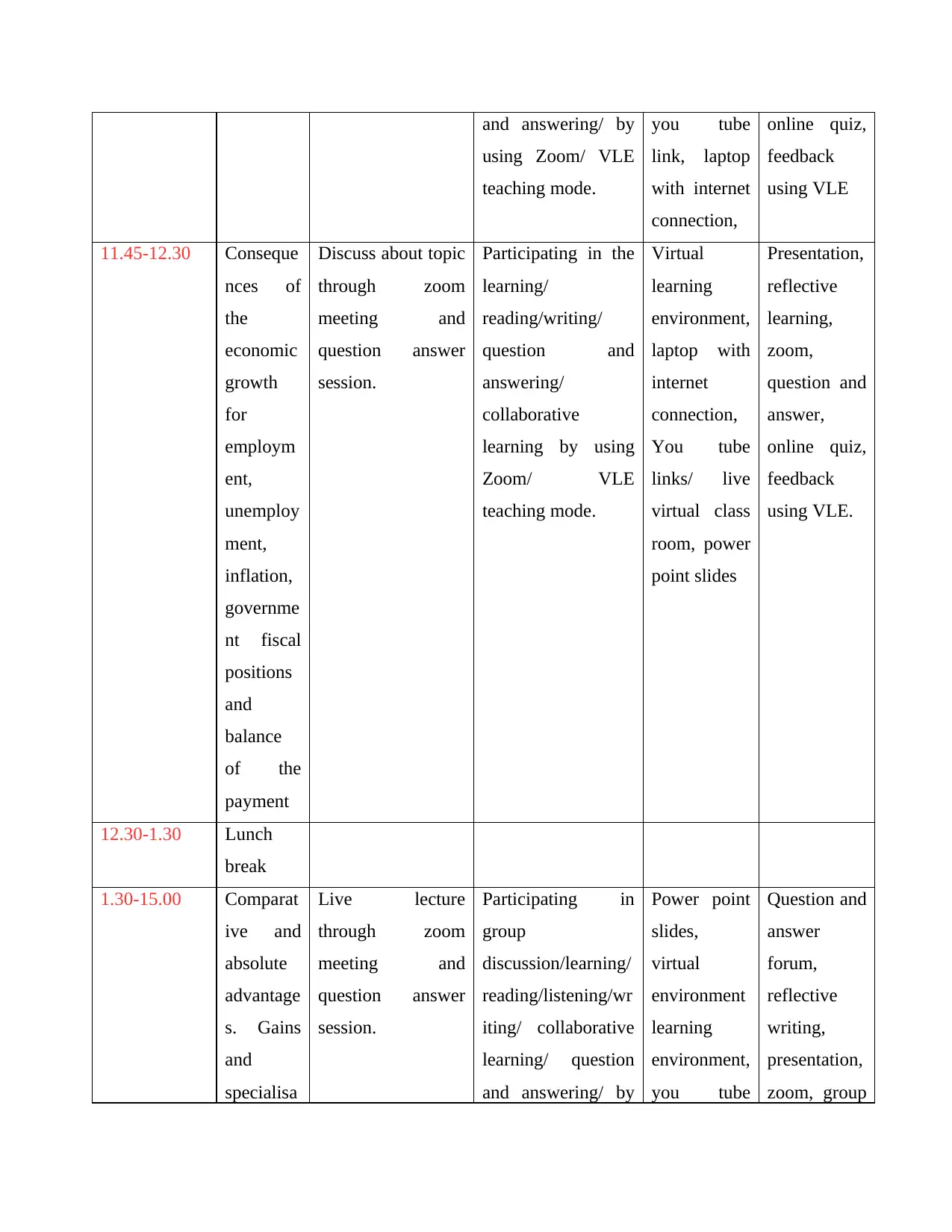
and answering/ by
using Zoom/ VLE
teaching mode.
you tube
link, laptop
with internet
connection,
online quiz,
feedback
using VLE
11.45-12.30 Conseque
nces of
the
economic
growth
for
employm
ent,
unemploy
ment,
inflation,
governme
nt fiscal
positions
and
balance
of the
payment
Discuss about topic
through zoom
meeting and
question answer
session.
Participating in the
learning/
reading/writing/
question and
answering/
collaborative
learning by using
Zoom/ VLE
teaching mode.
Virtual
learning
environment,
laptop with
internet
connection,
You tube
links/ live
virtual class
room, power
point slides
Presentation,
reflective
learning,
zoom,
question and
answer,
online quiz,
feedback
using VLE.
12.30-1.30 Lunch
break
1.30-15.00 Comparat
ive and
absolute
advantage
s. Gains
and
specialisa
Live lecture
through zoom
meeting and
question answer
session.
Participating in
group
discussion/learning/
reading/listening/wr
iting/ collaborative
learning/ question
and answering/ by
Power point
slides,
virtual
environment
learning
environment,
you tube
Question and
answer
forum,
reflective
writing,
presentation,
zoom, group
using Zoom/ VLE
teaching mode.
you tube
link, laptop
with internet
connection,
online quiz,
feedback
using VLE
11.45-12.30 Conseque
nces of
the
economic
growth
for
employm
ent,
unemploy
ment,
inflation,
governme
nt fiscal
positions
and
balance
of the
payment
Discuss about topic
through zoom
meeting and
question answer
session.
Participating in the
learning/
reading/writing/
question and
answering/
collaborative
learning by using
Zoom/ VLE
teaching mode.
Virtual
learning
environment,
laptop with
internet
connection,
You tube
links/ live
virtual class
room, power
point slides
Presentation,
reflective
learning,
zoom,
question and
answer,
online quiz,
feedback
using VLE.
12.30-1.30 Lunch
break
1.30-15.00 Comparat
ive and
absolute
advantage
s. Gains
and
specialisa
Live lecture
through zoom
meeting and
question answer
session.
Participating in
group
discussion/learning/
reading/listening/wr
iting/ collaborative
learning/ question
and answering/ by
Power point
slides,
virtual
environment
learning
environment,
you tube
Question and
answer
forum,
reflective
writing,
presentation,
zoom, group
Paraphrase This Document
Need a fresh take? Get an instant paraphrase of this document with our AI Paraphraser
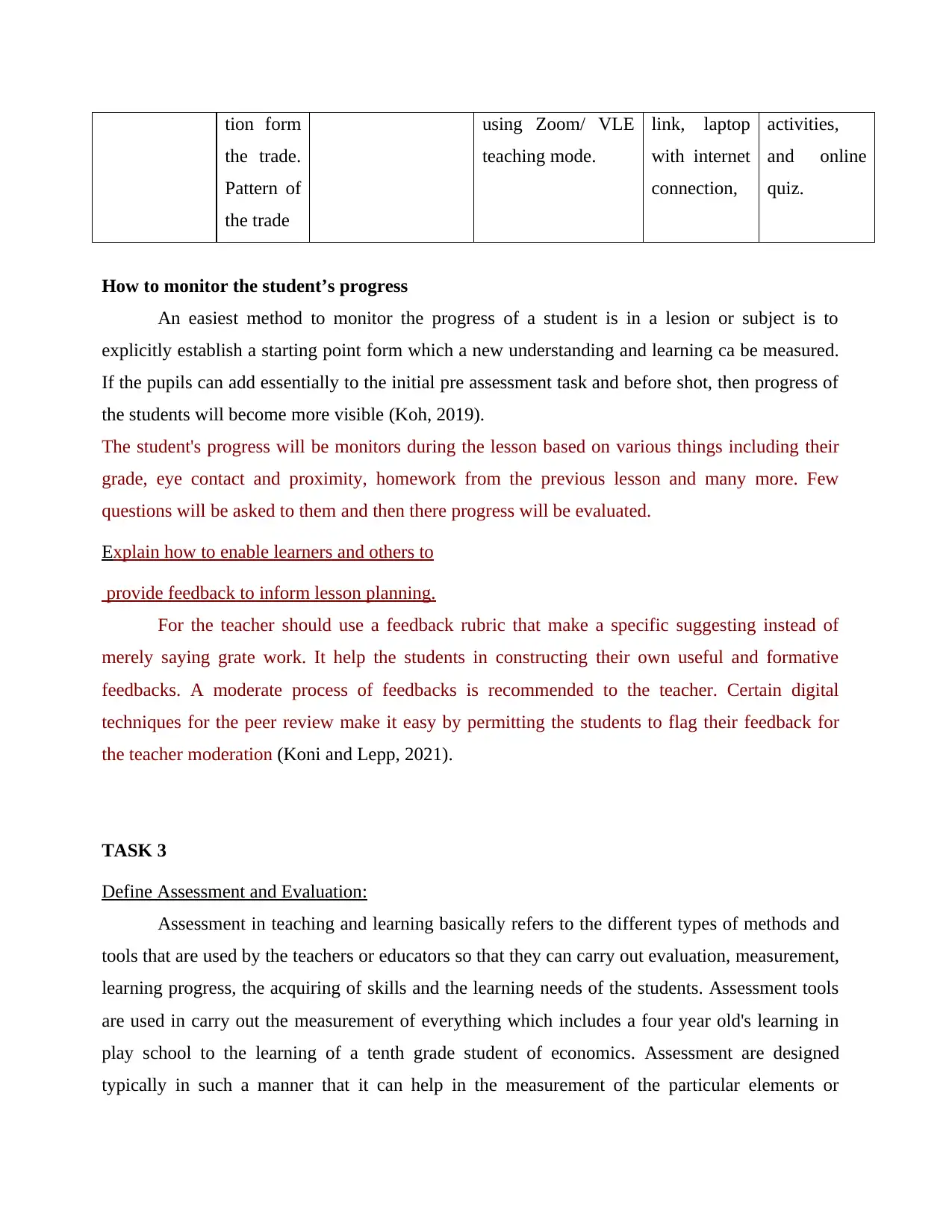
tion form
the trade.
Pattern of
the trade
using Zoom/ VLE
teaching mode.
link, laptop
with internet
connection,
activities,
and online
quiz.
How to monitor the student’s progress
An easiest method to monitor the progress of a student is in a lesion or subject is to
explicitly establish a starting point form which a new understanding and learning ca be measured.
If the pupils can add essentially to the initial pre assessment task and before shot, then progress of
the students will become more visible (Koh, 2019).
The student's progress will be monitors during the lesson based on various things including their
grade, eye contact and proximity, homework from the previous lesson and many more. Few
questions will be asked to them and then there progress will be evaluated.
Explain how to enable learners and others to
provide feedback to inform lesson planning.
For the teacher should use a feedback rubric that make a specific suggesting instead of
merely saying grate work. It help the students in constructing their own useful and formative
feedbacks. A moderate process of feedbacks is recommended to the teacher. Certain digital
techniques for the peer review make it easy by permitting the students to flag their feedback for
the teacher moderation (Koni and Lepp, 2021).
TASK 3
Define Assessment and Evaluation:
Assessment in teaching and learning basically refers to the different types of methods and
tools that are used by the teachers or educators so that they can carry out evaluation, measurement,
learning progress, the acquiring of skills and the learning needs of the students. Assessment tools
are used in carry out the measurement of everything which includes a four year old's learning in
play school to the learning of a tenth grade student of economics. Assessment are designed
typically in such a manner that it can help in the measurement of the particular elements or
the trade.
Pattern of
the trade
using Zoom/ VLE
teaching mode.
link, laptop
with internet
connection,
activities,
and online
quiz.
How to monitor the student’s progress
An easiest method to monitor the progress of a student is in a lesion or subject is to
explicitly establish a starting point form which a new understanding and learning ca be measured.
If the pupils can add essentially to the initial pre assessment task and before shot, then progress of
the students will become more visible (Koh, 2019).
The student's progress will be monitors during the lesson based on various things including their
grade, eye contact and proximity, homework from the previous lesson and many more. Few
questions will be asked to them and then there progress will be evaluated.
Explain how to enable learners and others to
provide feedback to inform lesson planning.
For the teacher should use a feedback rubric that make a specific suggesting instead of
merely saying grate work. It help the students in constructing their own useful and formative
feedbacks. A moderate process of feedbacks is recommended to the teacher. Certain digital
techniques for the peer review make it easy by permitting the students to flag their feedback for
the teacher moderation (Koni and Lepp, 2021).
TASK 3
Define Assessment and Evaluation:
Assessment in teaching and learning basically refers to the different types of methods and
tools that are used by the teachers or educators so that they can carry out evaluation, measurement,
learning progress, the acquiring of skills and the learning needs of the students. Assessment tools
are used in carry out the measurement of everything which includes a four year old's learning in
play school to the learning of a tenth grade student of economics. Assessment are designed
typically in such a manner that it can help in the measurement of the particular elements or
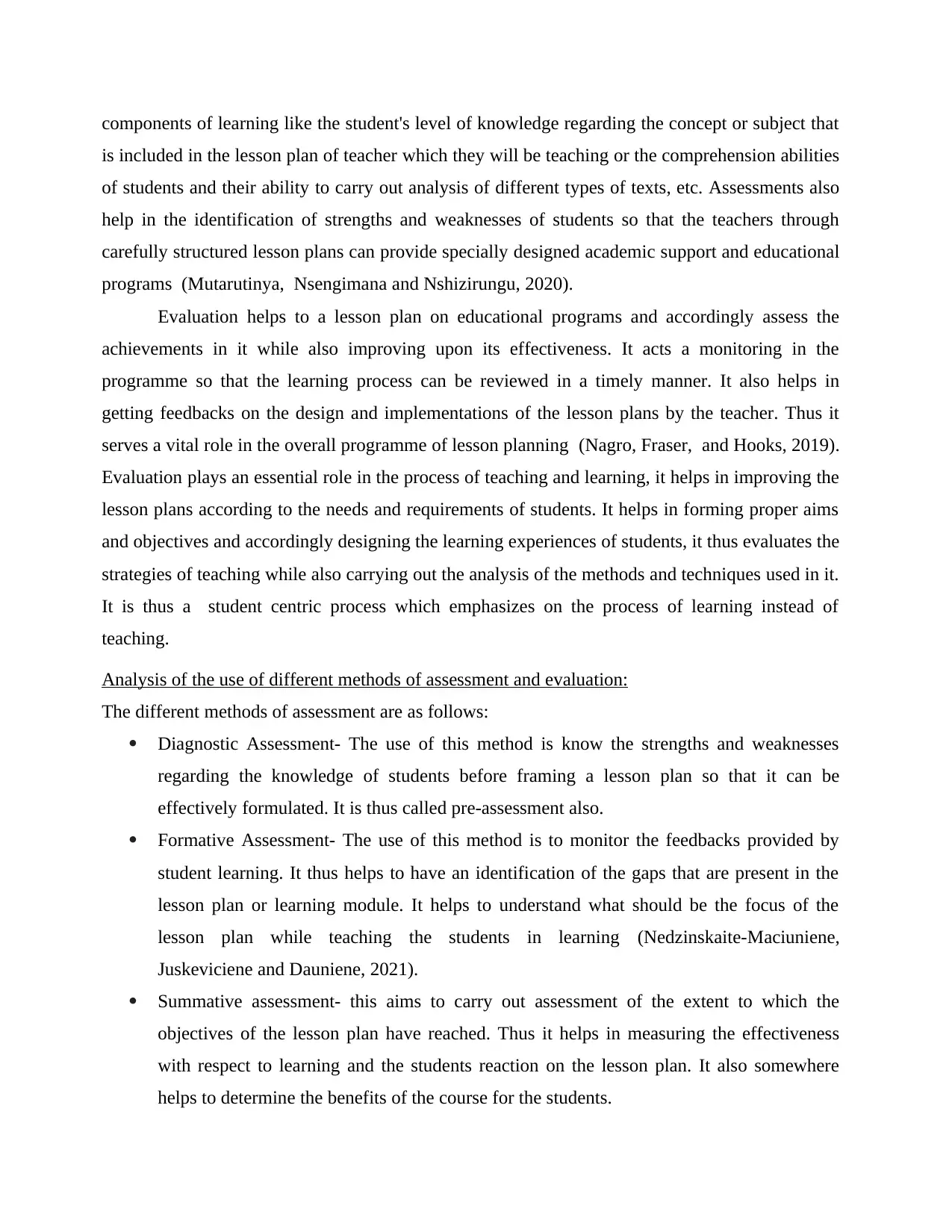
components of learning like the student's level of knowledge regarding the concept or subject that
is included in the lesson plan of teacher which they will be teaching or the comprehension abilities
of students and their ability to carry out analysis of different types of texts, etc. Assessments also
help in the identification of strengths and weaknesses of students so that the teachers through
carefully structured lesson plans can provide specially designed academic support and educational
programs (Mutarutinya, Nsengimana and Nshizirungu, 2020).
Evaluation helps to a lesson plan on educational programs and accordingly assess the
achievements in it while also improving upon its effectiveness. It acts a monitoring in the
programme so that the learning process can be reviewed in a timely manner. It also helps in
getting feedbacks on the design and implementations of the lesson plans by the teacher. Thus it
serves a vital role in the overall programme of lesson planning (Nagro, Fraser, and Hooks, 2019).
Evaluation plays an essential role in the process of teaching and learning, it helps in improving the
lesson plans according to the needs and requirements of students. It helps in forming proper aims
and objectives and accordingly designing the learning experiences of students, it thus evaluates the
strategies of teaching while also carrying out the analysis of the methods and techniques used in it.
It is thus a student centric process which emphasizes on the process of learning instead of
teaching.
Analysis of the use of different methods of assessment and evaluation:
The different methods of assessment are as follows:
Diagnostic Assessment- The use of this method is know the strengths and weaknesses
regarding the knowledge of students before framing a lesson plan so that it can be
effectively formulated. It is thus called pre-assessment also.
Formative Assessment- The use of this method is to monitor the feedbacks provided by
student learning. It thus helps to have an identification of the gaps that are present in the
lesson plan or learning module. It helps to understand what should be the focus of the
lesson plan while teaching the students in learning (Nedzinskaite-Maciuniene,
Juskeviciene and Dauniene, 2021).
Summative assessment- this aims to carry out assessment of the extent to which the
objectives of the lesson plan have reached. Thus it helps in measuring the effectiveness
with respect to learning and the students reaction on the lesson plan. It also somewhere
helps to determine the benefits of the course for the students.
is included in the lesson plan of teacher which they will be teaching or the comprehension abilities
of students and their ability to carry out analysis of different types of texts, etc. Assessments also
help in the identification of strengths and weaknesses of students so that the teachers through
carefully structured lesson plans can provide specially designed academic support and educational
programs (Mutarutinya, Nsengimana and Nshizirungu, 2020).
Evaluation helps to a lesson plan on educational programs and accordingly assess the
achievements in it while also improving upon its effectiveness. It acts a monitoring in the
programme so that the learning process can be reviewed in a timely manner. It also helps in
getting feedbacks on the design and implementations of the lesson plans by the teacher. Thus it
serves a vital role in the overall programme of lesson planning (Nagro, Fraser, and Hooks, 2019).
Evaluation plays an essential role in the process of teaching and learning, it helps in improving the
lesson plans according to the needs and requirements of students. It helps in forming proper aims
and objectives and accordingly designing the learning experiences of students, it thus evaluates the
strategies of teaching while also carrying out the analysis of the methods and techniques used in it.
It is thus a student centric process which emphasizes on the process of learning instead of
teaching.
Analysis of the use of different methods of assessment and evaluation:
The different methods of assessment are as follows:
Diagnostic Assessment- The use of this method is know the strengths and weaknesses
regarding the knowledge of students before framing a lesson plan so that it can be
effectively formulated. It is thus called pre-assessment also.
Formative Assessment- The use of this method is to monitor the feedbacks provided by
student learning. It thus helps to have an identification of the gaps that are present in the
lesson plan or learning module. It helps to understand what should be the focus of the
lesson plan while teaching the students in learning (Nedzinskaite-Maciuniene,
Juskeviciene and Dauniene, 2021).
Summative assessment- this aims to carry out assessment of the extent to which the
objectives of the lesson plan have reached. Thus it helps in measuring the effectiveness
with respect to learning and the students reaction on the lesson plan. It also somewhere
helps to determine the benefits of the course for the students.
⊘ This is a preview!⊘
Do you want full access?
Subscribe today to unlock all pages.

Trusted by 1+ million students worldwide
1 out of 18
Related Documents
Your All-in-One AI-Powered Toolkit for Academic Success.
+13062052269
info@desklib.com
Available 24*7 on WhatsApp / Email
![[object Object]](/_next/static/media/star-bottom.7253800d.svg)
Unlock your academic potential
Copyright © 2020–2025 A2Z Services. All Rights Reserved. Developed and managed by ZUCOL.




